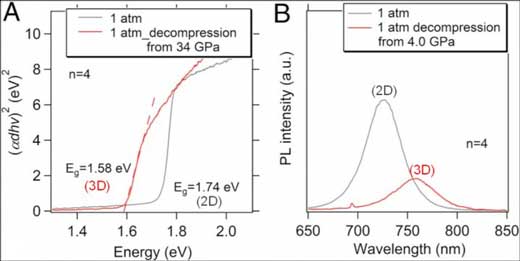| Aug 12, 2020 | |
Pressure-induced 2D-3D conversion in hybrid lead iodide layered perovskite(Nanowerk News) Hydrostatic pressurization can effectively lead to new and improved material properties. However, most of the novel material properties are only retainable at high-pressure states, and therefore warrant no practical applicability at ambient conditions. |
|
| Recently, a team of international scientists led by Dr. Lingping Kong and Dr. Gang Liu from HPSTAR reported permanent and irreversible transition of 2D hybrid Dion-Jacobson lead iodide perovskite to 3D perovskite phase at ambient conditions after pressure treatment. | |
| This work suggests the usefulness of high-pressure technique in preparing materials for real-situation applications. | |
 |
|
| 2D-3D transition in hybrid perovskites. (Image: Gang Liu) | |
| The results, as reported in PNAS ("Highly tunable properties in pressure-treated two-dimensional Dion–Jacobson perovskites"), marks crucial steps in utilizing pressure for ex-situ and ambient-environment applicability in engineering light-absorbing materials for high-performance optoelectronics and luminescence. | |
| Harnessing the pressure-induced properties has been a long-standing effort in the quest of exotic materials at ambient environment. Nevertheless, due to the order-disorder-order and recrystallization behaviors of material structures, desirable properties attainable at high-pressure states tend to be reversed at ambient pressure. | |
| From this sense, choosing materials with modifiable basis is imperatively important for permanent change in properties. Being a class of 2D metal halide perovskites, Dion-Jacobson perovskites represent a new material paradigm that is different from conventional Ruddlesden-Popper perovskite phase, in which D-J perovskites do not have the van der Waals gaps as encountered in R-P counterparts due to the divalent nature of interlayer organics. | |
| Such exotic structure ensures much shortened interlayer distance and greater structural rigidity, two important factors that can make sure irreversible structural phase transitions, and thus is electronically and atomically more resembling the 3D bulk phase. | |
| The scientist observed permanent and notable transition of 2D D-J phase (3AMP)(MA)3Pb4I13 to 3D MAPbI3 after 40 GPa pressure treatment, as proved by X-ray diffraction crystal structure after decompression. |
| Source: Center for High Pressure Science & Technology Advanced Research (HPSTAR) | |
|
Subscribe to a free copy of one of our daily Nanowerk Newsletter Email Digests with a compilation of all of the day's news. |
